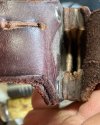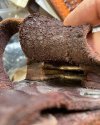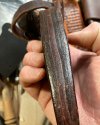- Joined
- Mar 22, 2022
- Messages
- 5
Maybe this seems difficult because it’s the first sheath I have ever made. I’m not a complete stranger to leather work as I have made a few wallets and slips for me and my friends, and even a purse for my mother.
I do have what I believe to be a decent challenge with a sheath I am making for a friend as the knife has a very minimal heel, no guard, and a thick handle. My first attempt, the handle pushed the back enough to allow the welt to kick up and expose the threads, which the blade obviously cut through.
Am I just not stitching tight enough, or do I need to change the design to accomodate for the thickness of the handle, or should I wet it and mold it around the handle?
I do have what I believe to be a decent challenge with a sheath I am making for a friend as the knife has a very minimal heel, no guard, and a thick handle. My first attempt, the handle pushed the back enough to allow the welt to kick up and expose the threads, which the blade obviously cut through.
Am I just not stitching tight enough, or do I need to change the design to accomodate for the thickness of the handle, or should I wet it and mold it around the handle?







